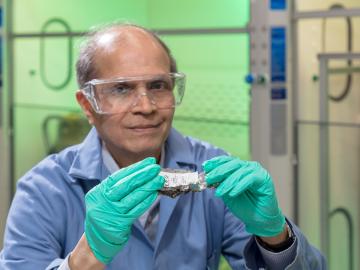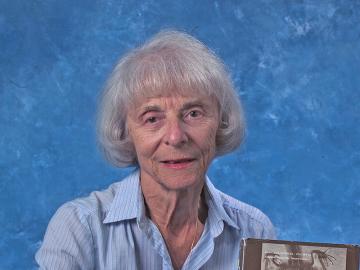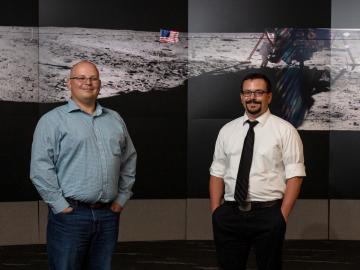
Filter News
Area of Research
- Biological Systems (1)
- Biology and Environment (33)
- Clean Energy (51)
- Climate and Environmental Systems (1)
- Computer Science (2)
- Electricity and Smart Grid (1)
- Fuel Cycle Science and Technology (1)
- Fusion and Fission (14)
- Fusion Energy (3)
- Isotopes (10)
- Materials (44)
- National Security (18)
- Neutron Science (24)
- Nuclear Science and Technology (3)
- Supercomputing (55)
News Type
News Topics
- 3-D Printing/Advanced Manufacturing (11)
- Advanced Reactors (1)
- Artificial Intelligence (18)
- Big Data (8)
- Bioenergy (13)
- Biology (16)
- Biomedical (5)
- Biotechnology (2)
- Buildings (6)
- Chemical Sciences (10)
- Clean Water (7)
- Climate Change (17)
- Composites (2)
- Computer Science (22)
- Coronavirus (1)
- Critical Materials (1)
- Cybersecurity (6)
- Decarbonization (17)
- Emergency (1)
- Energy Storage (10)
- Environment (36)
- Exascale Computing (12)
- Fossil Energy (2)
- Frontier (13)
- Fusion (7)
- Grid (11)
- High-Performance Computing (18)
- Hydropower (2)
- Isotopes (7)
- Machine Learning (11)
- Materials (21)
- Materials Science (8)
- Mathematics (2)
- Mercury (2)
- Microelectronics (2)
- Microscopy (3)
- Nanotechnology (5)
- National Security (15)
- Net Zero (3)
- Neutron Science (23)
- Nuclear Energy (19)
- Partnerships (6)
- Physics (11)
- Polymers (2)
- Quantum Computing (6)
- Quantum Science (5)
- Renewable Energy (1)
- Security (1)
- Simulation (19)
- Software (1)
- Space Exploration (5)
- Summit (11)
- Sustainable Energy (10)
- Transportation (7)
Media Contacts

More than 6,000 veterans died by suicide in 2016, and from 2005 to 2016, the rate of veteran suicides in the United States increased by more than 25 percent.

Artificial intelligence (AI) techniques have the potential to support medical decision-making, from diagnosing diseases to prescribing treatments. But to prioritize patient safety, researchers and practitioners must first ensure such methods are accurate.

Materials scientists, electrical engineers, computer scientists, and other members of the neuromorphic computing community from industry, academia, and government agencies gathered in downtown Knoxville July 23–25 to talk about what comes next in

Six new nuclear reactor technologies are set to deploy for commercial use between 2030 and 2040. Called Generation IV nuclear reactors, they will operate with improved performance at dramatically higher temperatures than today’s reactors.

Isabelle Snyder calls faults as she sees them, whether it’s modeling operations for the nation’s power grid or officiating at the US Open Tennis Championships.

Rare earth elements are the “secret sauce” of numerous advanced materials for energy, transportation, defense and communications applications.

Early career scientist Stephanie Galanie has applied her expertise in synthetic biology to a number of challenges in academia and private industry. She’s now bringing her skills in high-throughput bio- and analytical chemistry to accelerate research on feedstock crops as a Liane B. Russell Fellow at Oak Ridge National Laboratory.

Mammalian genetics pioneer Liane B. Russell died Saturday, July 20. She was 95. Lee, as she was known to friends and colleagues, arrived in Oak Ridge in 1947 with her husband, William L. Russell, to study radiation-induced health effects using mice, which are genetically similar to humans.

In Hong Wang’s world, nothing is beyond control. Before joining Oak Ridge National Laboratory as a senior distinguished researcher in transportation systems, he spent more than three decades studying the control of complex industrial systems in the United Kingdom.

Just minutes after taking one small step for man, one giant leap for mankind, Neil Armstrong deviated from NASA’s meticulously crafted flight plan for the Apollo 11 mission. According to NASA’s lunar surface operations plan, Armstrong’s top priority after his famous first steps should have been to immediately take a contingency sample—a small sample of soil—to provide scientists at least a piece of the moon if the mission had to be abandoned early.


